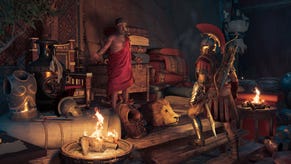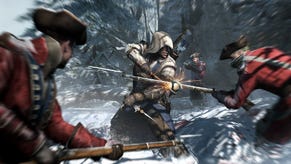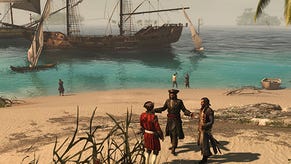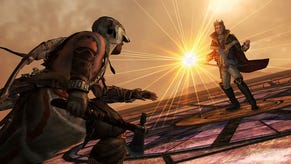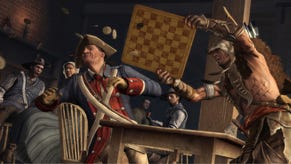Hands-on: Assassin's Creed 3
"His squeak still haunts me"
Craig was sent into the heart of Ubisoft to bring back this Assassin’s Creed 3 report, dead or alive.
I love Assassin's Creed, but it's a series begging for some tight editing. Scratch that, it's series that needs someone sat at the developer's offices wearing a giant listening device that points in every direction. This person will have a buzzer to press anytime a developer strays away from the two-storey high blackboard drawing of an assassin stabbing people. "I had a great idea! Ezio could be a property manager - " *BUZZ!*. "So I'm taking this to Jade: what if we had first-person puzz - " *BUZZ! BUZZ!*. "Hey everybody, let's add in naval bat - !" *BUZZZZZZZZZZZZZZZZZZ!*
My playthrough of Assassin's Creed 3 lasted three hours. I experienced the new open-world, where the forested areas of Revolutionary America are rife with animals to hunt, trees to climb, and communal activities. I took a ship into battle, which now counts as the series' most over the top and bizarre inclusion. And I made it to Boston, a powderkeg of the New World, full of roofs to rampage over and people to perforate.
I'm dropped in a few hours into the game. Connor, the new hero, is half-British half-Native and his homestead reflects this: it's a colonial mansion, but situated in the wilderness. His homestead is where a number of missions will begin, and where he'll gather people and trophies. I go for a jog through the forest, hopping up a tree and along the branches to get a feel of the American wilderness. The woodlands aren't just an aesthetic addition: they present a different challenge to skipping across the rooftops. The wilderness is a less forgiving free-running environment, because the trees don't have clean lines to line up when running. The routes are more prescribed, but the angles are a bit more difficult to anticipate at high speed. It took me an hour to get comfortable, but the key to enjoying the woody wilderness is to slow down and pick your way along. Even knowing that, there's a moment where going slow doesn't bear fruit: I spot a viewpoint at the peak of a tree that I decide I need to ascend to. I aim for what appears to be a reachable branch, and each time I plummet. I take my time, I scour the rest of the area for different spots to grab, but I never seem to figure it out. This didn't happen in the city. Trees, man.

While Ezio's anger and need for revenge drove the previous three games, Connor is more interested in integration. His home covers a significant amount of land, and the map shows off 'homestead missions' that'll bring itinerants together to flourish as a community. I'm introduced to one when I hear a call for help while picking my way through some branches. The begging leads me to an injured hunter. She'd been attacked by poaching British soldiers and couldn't walk. I collect her carry her back to the homestead, making her an offer that means she can hunt on my land as long as she trades with the residents. She's the first of a few people I offer sanctuary to.
But the hunters that injured her are fair game. I take to the branches again, still clumsily, and tripping cautiously through branches as I head to the map marker. There are three of them, all unaware I'm sat on a branch over their heads. Dogs Guards can't look up. It's a classic Assassin's Creed set-up, but this time I have a new weapon: the ropedart. It's basically a knife attached to a line that can be used in the way that all pointy things on ropes can be used. I hope they'll patrol underneath me, but they just hang around chatting, forcing me to move to the closest branch and launch a dart from there. It catches my target and hoists him high into the air as I drop down, using my weight to hang him. I quickly switch to my hidden blades and catch the other two in a double stab. It was slick. More tools for emergent assassinations are a welcome addition.
But there are more hunters, and I don't have the element of surprise anymore. I use my lack of surprise as the surprise itself and run uncaringly at them, flicking out a tomahawk and burying it in the first's chest. The second is released as a warning to those that might cross me further: I have ropedarts and axes, and you won't see me coming.

Among the activities in the wilderness, which includes finding conversations, playing minigames, rescuing farmers, and uncovering relics, you can also hunt. The creatures are skinned for pelt that you can trade for supplies. But first you need to kill them. I look around for potential targets. Maybe there's a bear? Or a wolf? Or a bear/wolf hybrid that can claw...ooh a raccoon! I begin stalking him, ducking into undergrowth for cover. I plan on drawing a bow out and killing it from a short distance, but it takes off before I can. It leads me to a ridiculous chase, where I run up a fallen tree (used to get into the branches to stalk things) so I can scan the area for it. I spot it and drop, hidden blades poised as I take up the chase. There's no dramatic leap when I catch up: I drop to the ground, bend over and...
*stab*
"Squeak!"
His squeak still haunts me. Later on, on a farm, I pet a cow (really, it's an option). It made me feel a bit better.

I take a break from hunting and fast-travel (a new addition) to the coast to see what the naval battles bring to the series. Because I've been dropped into the game there's no introduction up to explain why I have to take control of a boat, but I chat to the harbourmaster and find myself at the helm of a ship. I head out to sea and select a mission to protect a merchant ship from a gaggle of gunboats. It's an odd feeling: a game about keen, sharp movement is now about trying to keep a boat under control, forcing me to think in long, slow, arcs. I have cannons and guns to line up on each side of the boat, but each turn of the ship feels sluggish. At least the gunboats are easy to wreck: one barrage from any of the weapons leaves them splintered and sinking, but as I attempt to stifle their movement I lose sense of my position. I crash into rocks and bump into the boat I'm supposed to be protecting. Part of the trouble is the ship's bulk obscures a lot of the screen, so I'm fighting that as well as the lumpen controls. Slowing down to half speed helps, but it means the fight takes off without me.
The battle is in three beats. I manage to defeat the gunboats, barely limping out alive. The second section involves navigating a corridor of rocky outcrops and mines, with a few stealthy boats ready to attack. At least it can be taken at my own pace, but it's still cumbersome, and a bit more fiddly than the previous section. It's easiest to just line up the ship sideways and blast every mine in sight from a distance, then move on.

The final section is a real oddity: the escorted ship peels away and I'm left fighting a fort. It's blasting out into the sea, and I have to move the lumbering, awkward ship around the projectiles, while attempting to angle my cannons to respond. The balancing act here is that it's easier to avoid being hit by turning towards the forts, but you need to be sideways to fire. It's not complicated, but it's still annoyingly tough to manoeuvre. I eventually manage it, after sinking twice, by coming to complete halt and firing a few rounds, then moving on when the forts barrage. It doesn't feel in the spirit of things. I want movement to be key in Assassin's Creed, and it doesn't necessarily need to be easy, but I'm not convinced it's a good addition to the series.
I hit land and spend some time climbing and running around the surrounding buildings and woods to shake the fog of the battle from my bones. I find a pirate called Pegleg, who asks me to hunt some artefacts, but I don't have the time to spare. I bring up the map and hunt for the fast-travel options. I aim for Boston. The city of Cheers.
It's a squat little city: easier to run around than the woods, but not as grand as the Italian renaissance regions of previous games. It feels smokey and busy. Here is where I picked up a thread of the main story, where the Templars are harassing locals and the British are stocking up on drinkables. This is where Jim is going to hate me. This where I destroy the tea.
I have a trio of targets in the docks to blow up, and half a city to run over to get there. Even without local knowledge of a Bostonian, it's immediately easier to get around than in the forests: running, grabbing, diving and hiding here are all so familiar to my fingers that I'm instantly elated. Sprinting over the gabled cityscape is joyous, and there's a few additional moves: my favourite is that certain houses can be passed through to shake chasing guards, with a swoopy camera ripped right out of the Bourne movies. It's such a pleasing visual effect that I grab the chance wherever I see an open window.

Along the way there are things to do. Most prominently there are Templars to kill. They pop up on the map, little groups of thugs surrounding locals. Social responsibility is important to Connor, so I drop down into a small square to stop a beating. Things only kick off if I choose to, so I whip a ropedart into the main Templar, dragging him away from his target, and everyone surrounds me. There's not a huge amount of difference in the combat system: it's still a balancing act between assaults and blocking, pushing in aggressively with Connor's tomahawk and looking around for secondary attacks to counter into a combo. It's still slick, although it feels a tad slow post-Arkham City. It's also a lot easier to die in battle, as there's no active healing when you're in a fight. You need to escape to fix yourself up, or fight on and hope you don't slip up. In this case, after the arrival of a gunner on horse-back, I need to vanish. I hop up on a small tent in the square and leap from there onto a cart. I expected to dive into it, but instead Connor uses it as a stepping stone to boost up onto a building.
I take to the rooftops, ignoring a few people begging for help, and stop myself from climbing the viewpoint towers to get a better view of the sprawling city. Like the frontier, there's lots of incidental events, but I feel compelled to complete a bit of the story and aim for the seaside. The docks have a playground vibe: I sneak in using some people to squeeze past the British soldiers, then I bypass another patrol by swinging over monkey bars set into a roof. My targets are tea shipments. It can be as easy or as hard as I want it to be, and I use Connor's new corner lean ability to keep out of the way, and sneak over roofs to bypass patrols and plant the bombs.
Truthfully, I was a little too stealthy here and got away with planting the three bombs and destroying the goods without being seen. Satisfying, but not a particularly dramatic way to end the demo. No escapes from the clutches of angry, tea-deprived Brits. I just climb up to the roofs and dart off. But I did kill some tea. Sorry, Jim.
Every time I've ever played Assassin's Creed, there's a bit of a 'but' hanging over it. The base game is as good and as slick as ever, and taking the time to understand the quirks of the woodland's effect on movement really does pay off. The surrounding game is impressive. There's a lot more going on, with multiple quests running contiguously, and the growth of the town that Connor is building grounds the silly property management stuff in little vignettes of human drama: by the end of the game he'll be surrounded by rescued friends, all contributing to his little commune. But my future enjoyment depends on how much the naval activities will encroach on the land fun. There might be a way to squeeze some enjoyment out of it: they are spectacular looking, but they still feel like a strange, forced addition. I hope there's plenty of asassy sassiness to balance it out.
Assassin's Creed III will appear on the PC machines on 20th of November in North American, and then three days later in Europe. For some reason.





